HR Skills, Performance Management, and Organizational Development
VerifiedAdded on 2020/10/22
|15
|4357
|408
Report
AI Summary
This report provides a comprehensive analysis of the essential skills, knowledge, and behaviors required for HR professionals, with a specific focus on their application within Whirlpool Corporation. The report begins by evaluating the core competencies needed by HR professionals, including contract law, management, communication, and conflict resolution. A personal skills audit is conducted to identify strengths and weaknesses, followed by a development plan for improvement. The report then differentiates between organizational and individual learning, highlighting the importance of continuous learning and professional development in driving sustainable business performance. It explores the differences between training and development programs. Finally, the report examines the impact of high-performance work systems on employee engagement and competitive advantage, and discusses different approaches to performance management, providing specific examples to illustrate their practical application. The report emphasizes the interconnectedness of individual, team, and organizational development, underscoring HR's vital role in fostering a productive and harmonious work environment.
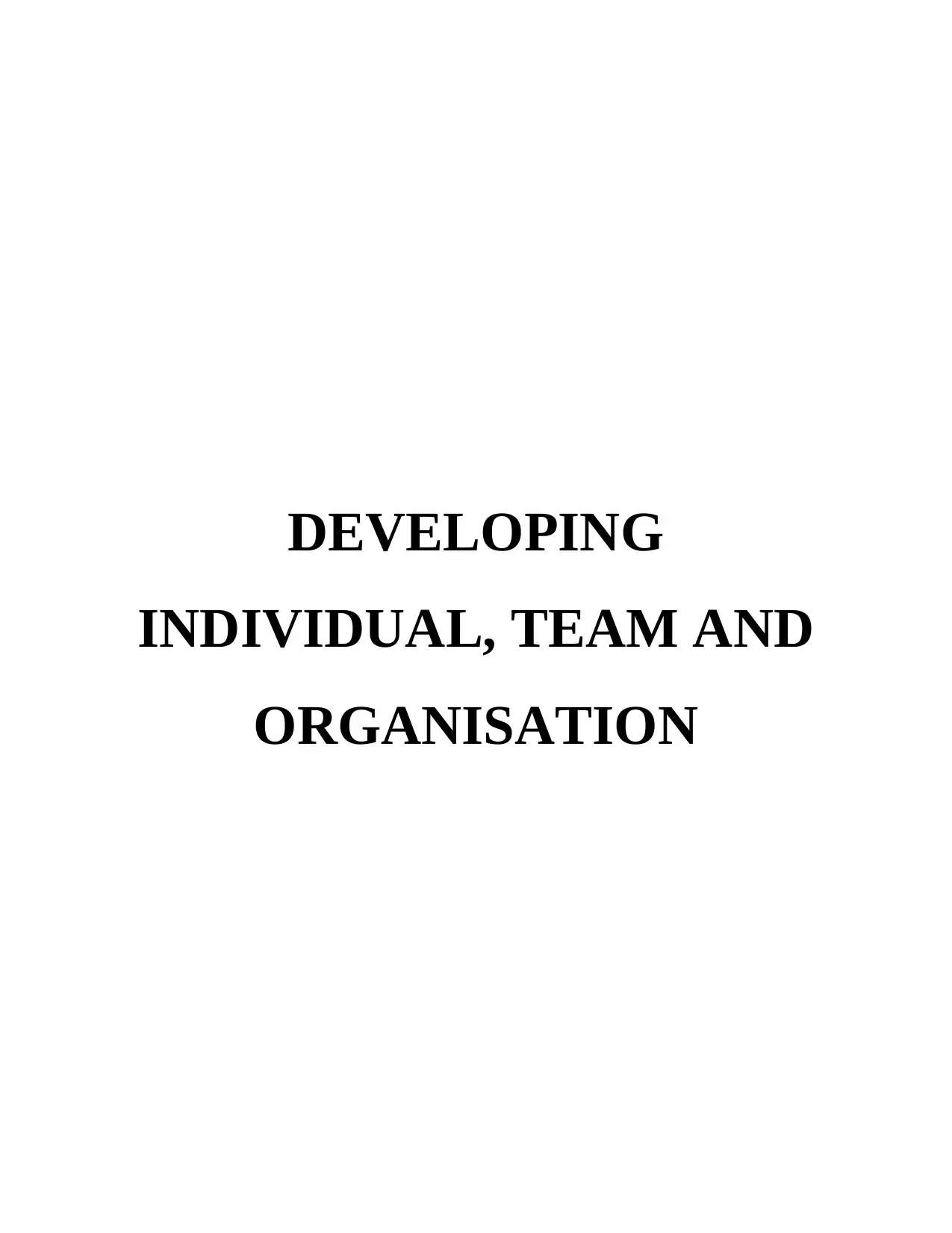
DEVELOPING
INDIVIDUAL, TEAM AND
ORGANISATION
INDIVIDUAL, TEAM AND
ORGANISATION
Paraphrase This Document
Need a fresh take? Get an instant paraphrase of this document with our AI Paraphraser
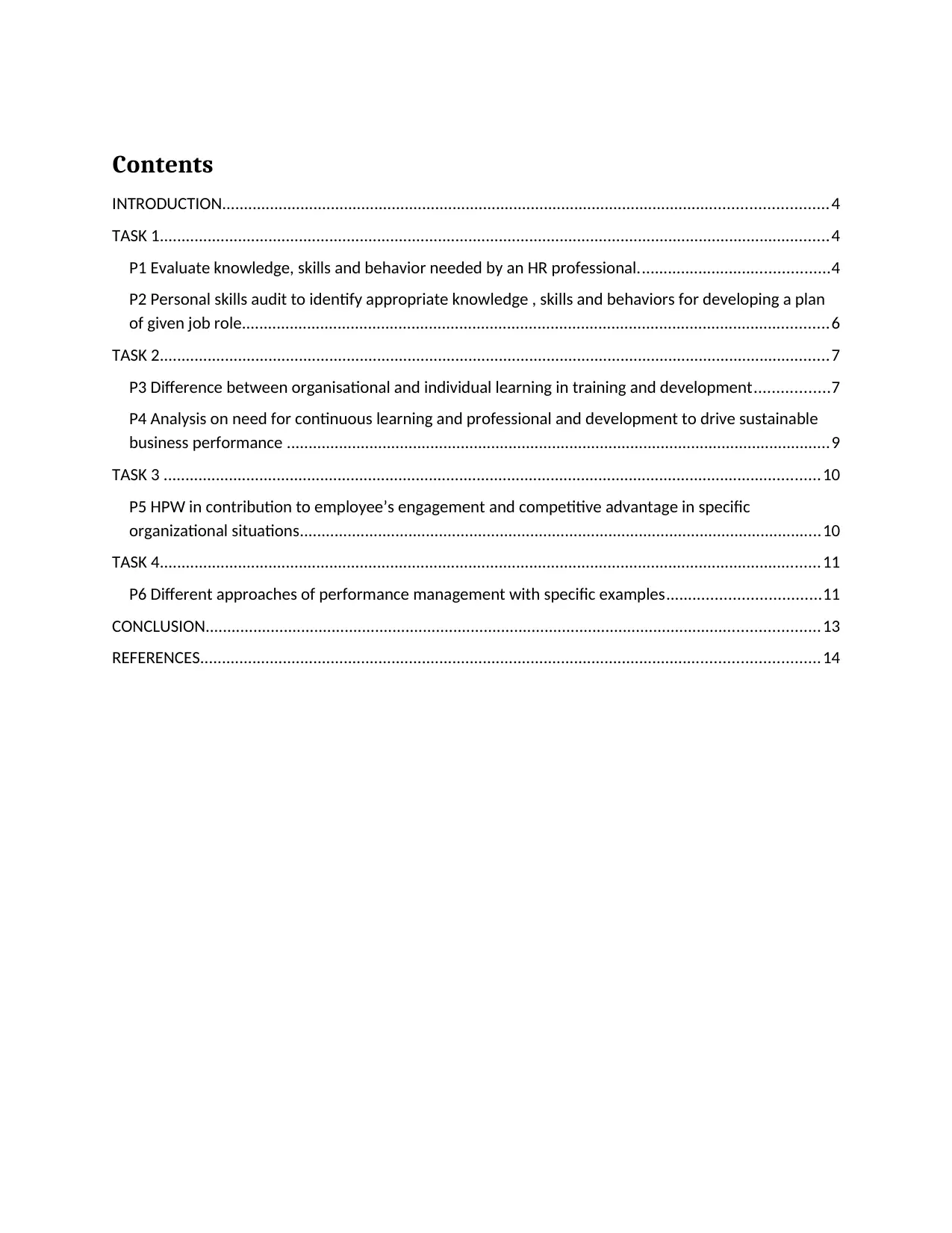
Contents
INTRODUCTION...........................................................................................................................................4
TASK 1..........................................................................................................................................................4
P1 Evaluate knowledge, skills and behavior needed by an HR professional............................................4
P2 Personal skills audit to identify appropriate knowledge , skills and behaviors for developing a plan
of given job role.......................................................................................................................................6
TASK 2..........................................................................................................................................................7
P3 Difference between organisational and individual learning in training and development.................7
P4 Analysis on need for continuous learning and professional and development to drive sustainable
business performance .............................................................................................................................9
TASK 3 .......................................................................................................................................................10
P5 HPW in contribution to employee’s engagement and competitive advantage in specific
organizational situations........................................................................................................................10
TASK 4........................................................................................................................................................11
P6 Different approaches of performance management with specific examples...................................11
CONCLUSION.............................................................................................................................................13
REFERENCES..............................................................................................................................................14
INTRODUCTION...........................................................................................................................................4
TASK 1..........................................................................................................................................................4
P1 Evaluate knowledge, skills and behavior needed by an HR professional............................................4
P2 Personal skills audit to identify appropriate knowledge , skills and behaviors for developing a plan
of given job role.......................................................................................................................................6
TASK 2..........................................................................................................................................................7
P3 Difference between organisational and individual learning in training and development.................7
P4 Analysis on need for continuous learning and professional and development to drive sustainable
business performance .............................................................................................................................9
TASK 3 .......................................................................................................................................................10
P5 HPW in contribution to employee’s engagement and competitive advantage in specific
organizational situations........................................................................................................................10
TASK 4........................................................................................................................................................11
P6 Different approaches of performance management with specific examples...................................11
CONCLUSION.............................................................................................................................................13
REFERENCES..............................................................................................................................................14
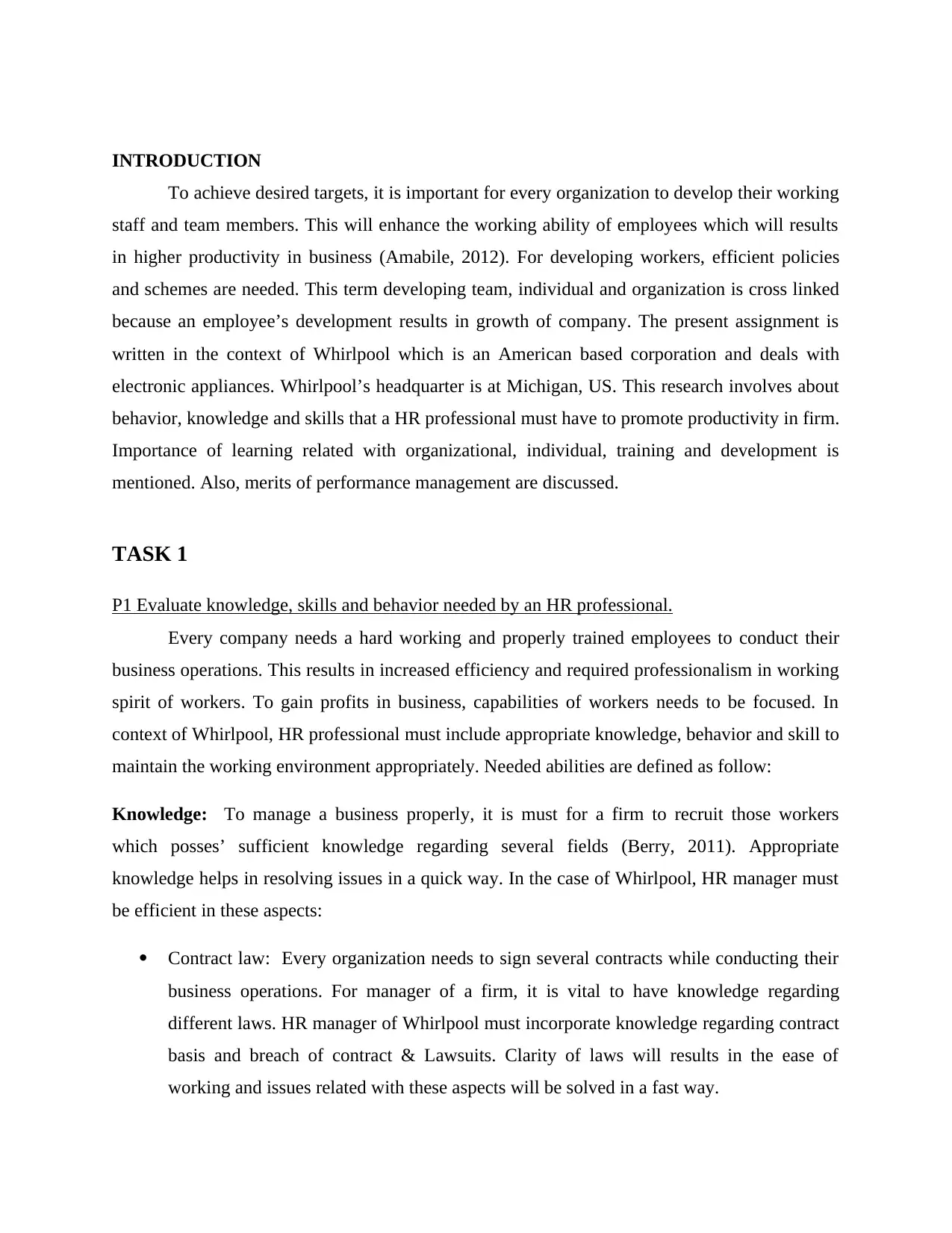
INTRODUCTION
To achieve desired targets, it is important for every organization to develop their working
staff and team members. This will enhance the working ability of employees which will results
in higher productivity in business (Amabile, 2012). For developing workers, efficient policies
and schemes are needed. This term developing team, individual and organization is cross linked
because an employee’s development results in growth of company. The present assignment is
written in the context of Whirlpool which is an American based corporation and deals with
electronic appliances. Whirlpool’s headquarter is at Michigan, US. This research involves about
behavior, knowledge and skills that a HR professional must have to promote productivity in firm.
Importance of learning related with organizational, individual, training and development is
mentioned. Also, merits of performance management are discussed.
TASK 1
P1 Evaluate knowledge, skills and behavior needed by an HR professional.
Every company needs a hard working and properly trained employees to conduct their
business operations. This results in increased efficiency and required professionalism in working
spirit of workers. To gain profits in business, capabilities of workers needs to be focused. In
context of Whirlpool, HR professional must include appropriate knowledge, behavior and skill to
maintain the working environment appropriately. Needed abilities are defined as follow:
Knowledge: To manage a business properly, it is must for a firm to recruit those workers
which posses’ sufficient knowledge regarding several fields (Berry, 2011). Appropriate
knowledge helps in resolving issues in a quick way. In the case of Whirlpool, HR manager must
be efficient in these aspects:
Contract law: Every organization needs to sign several contracts while conducting their
business operations. For manager of a firm, it is vital to have knowledge regarding
different laws. HR manager of Whirlpool must incorporate knowledge regarding contract
basis and breach of contract & Lawsuits. Clarity of laws will results in the ease of
working and issues related with these aspects will be solved in a fast way.
To achieve desired targets, it is important for every organization to develop their working
staff and team members. This will enhance the working ability of employees which will results
in higher productivity in business (Amabile, 2012). For developing workers, efficient policies
and schemes are needed. This term developing team, individual and organization is cross linked
because an employee’s development results in growth of company. The present assignment is
written in the context of Whirlpool which is an American based corporation and deals with
electronic appliances. Whirlpool’s headquarter is at Michigan, US. This research involves about
behavior, knowledge and skills that a HR professional must have to promote productivity in firm.
Importance of learning related with organizational, individual, training and development is
mentioned. Also, merits of performance management are discussed.
TASK 1
P1 Evaluate knowledge, skills and behavior needed by an HR professional.
Every company needs a hard working and properly trained employees to conduct their
business operations. This results in increased efficiency and required professionalism in working
spirit of workers. To gain profits in business, capabilities of workers needs to be focused. In
context of Whirlpool, HR professional must include appropriate knowledge, behavior and skill to
maintain the working environment appropriately. Needed abilities are defined as follow:
Knowledge: To manage a business properly, it is must for a firm to recruit those workers
which posses’ sufficient knowledge regarding several fields (Berry, 2011). Appropriate
knowledge helps in resolving issues in a quick way. In the case of Whirlpool, HR manager must
be efficient in these aspects:
Contract law: Every organization needs to sign several contracts while conducting their
business operations. For manager of a firm, it is vital to have knowledge regarding
different laws. HR manager of Whirlpool must incorporate knowledge regarding contract
basis and breach of contract & Lawsuits. Clarity of laws will results in the ease of
working and issues related with these aspects will be solved in a fast way.
⊘ This is a preview!⊘
Do you want full access?
Subscribe today to unlock all pages.

Trusted by 1+ million students worldwide
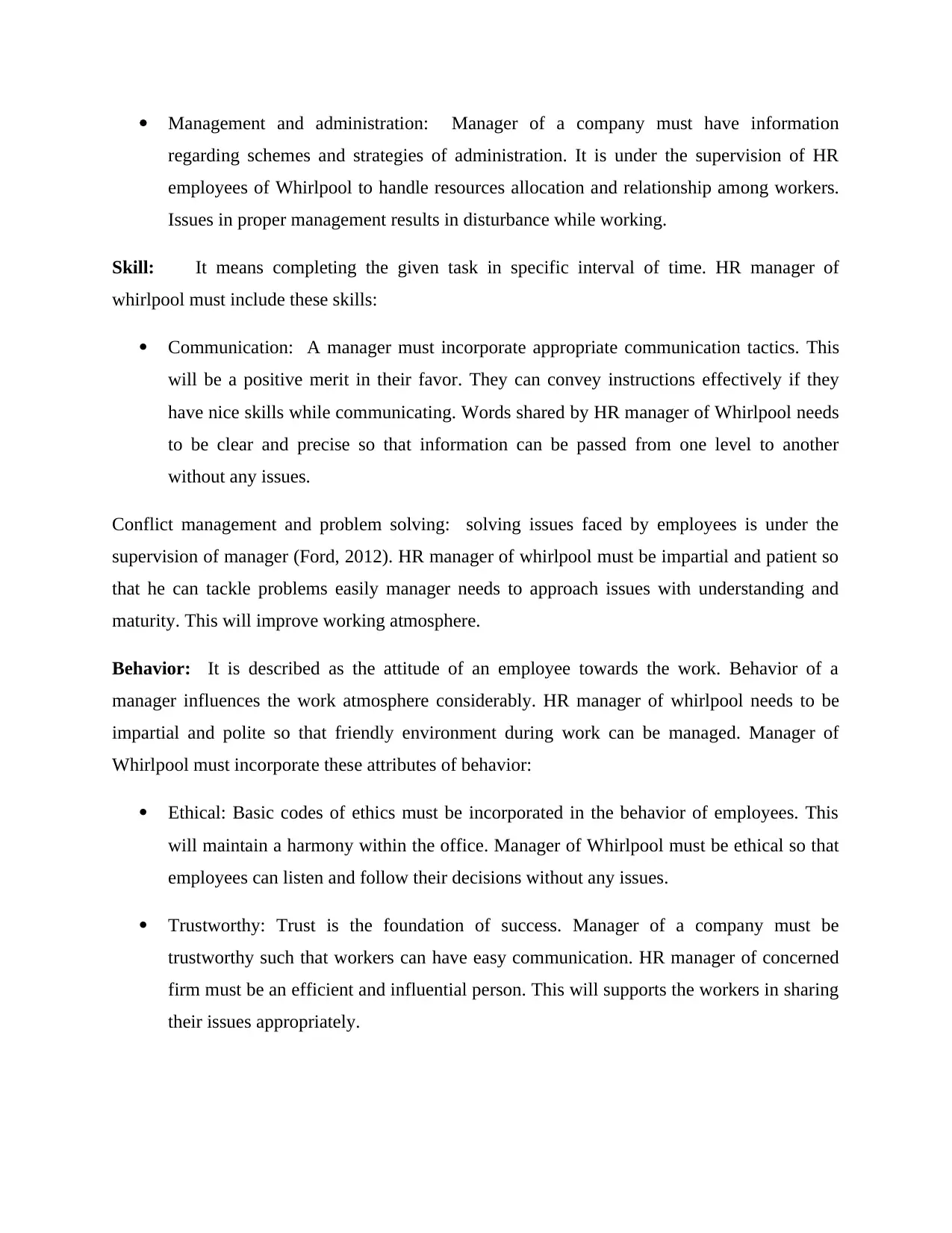
Management and administration: Manager of a company must have information
regarding schemes and strategies of administration. It is under the supervision of HR
employees of Whirlpool to handle resources allocation and relationship among workers.
Issues in proper management results in disturbance while working.
Skill: It means completing the given task in specific interval of time. HR manager of
whirlpool must include these skills:
Communication: A manager must incorporate appropriate communication tactics. This
will be a positive merit in their favor. They can convey instructions effectively if they
have nice skills while communicating. Words shared by HR manager of Whirlpool needs
to be clear and precise so that information can be passed from one level to another
without any issues.
Conflict management and problem solving: solving issues faced by employees is under the
supervision of manager (Ford, 2012). HR manager of whirlpool must be impartial and patient so
that he can tackle problems easily manager needs to approach issues with understanding and
maturity. This will improve working atmosphere.
Behavior: It is described as the attitude of an employee towards the work. Behavior of a
manager influences the work atmosphere considerably. HR manager of whirlpool needs to be
impartial and polite so that friendly environment during work can be managed. Manager of
Whirlpool must incorporate these attributes of behavior:
Ethical: Basic codes of ethics must be incorporated in the behavior of employees. This
will maintain a harmony within the office. Manager of Whirlpool must be ethical so that
employees can listen and follow their decisions without any issues.
Trustworthy: Trust is the foundation of success. Manager of a company must be
trustworthy such that workers can have easy communication. HR manager of concerned
firm must be an efficient and influential person. This will supports the workers in sharing
their issues appropriately.
regarding schemes and strategies of administration. It is under the supervision of HR
employees of Whirlpool to handle resources allocation and relationship among workers.
Issues in proper management results in disturbance while working.
Skill: It means completing the given task in specific interval of time. HR manager of
whirlpool must include these skills:
Communication: A manager must incorporate appropriate communication tactics. This
will be a positive merit in their favor. They can convey instructions effectively if they
have nice skills while communicating. Words shared by HR manager of Whirlpool needs
to be clear and precise so that information can be passed from one level to another
without any issues.
Conflict management and problem solving: solving issues faced by employees is under the
supervision of manager (Ford, 2012). HR manager of whirlpool must be impartial and patient so
that he can tackle problems easily manager needs to approach issues with understanding and
maturity. This will improve working atmosphere.
Behavior: It is described as the attitude of an employee towards the work. Behavior of a
manager influences the work atmosphere considerably. HR manager of whirlpool needs to be
impartial and polite so that friendly environment during work can be managed. Manager of
Whirlpool must incorporate these attributes of behavior:
Ethical: Basic codes of ethics must be incorporated in the behavior of employees. This
will maintain a harmony within the office. Manager of Whirlpool must be ethical so that
employees can listen and follow their decisions without any issues.
Trustworthy: Trust is the foundation of success. Manager of a company must be
trustworthy such that workers can have easy communication. HR manager of concerned
firm must be an efficient and influential person. This will supports the workers in sharing
their issues appropriately.
Paraphrase This Document
Need a fresh take? Get an instant paraphrase of this document with our AI Paraphraser
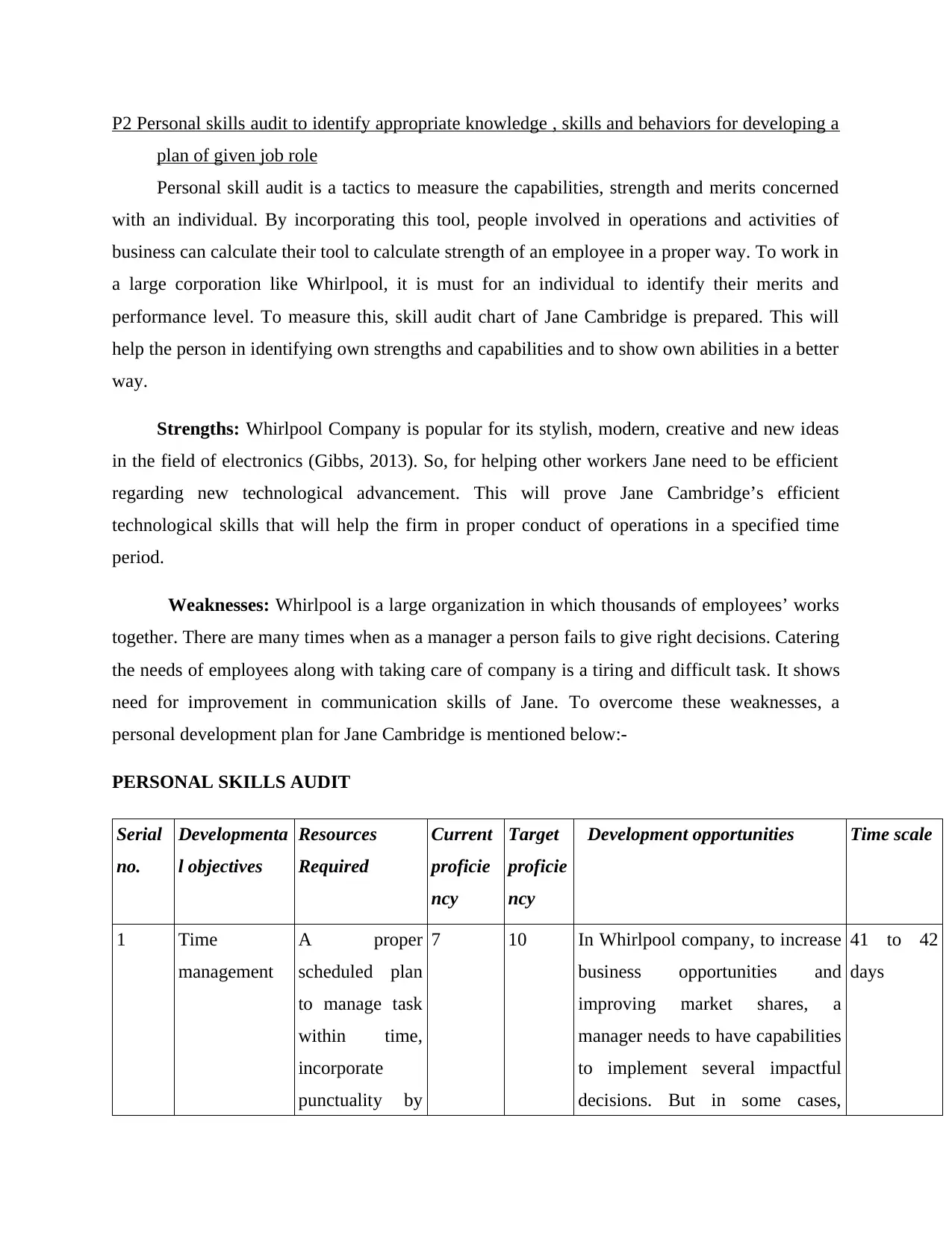
P2 Personal skills audit to identify appropriate knowledge , skills and behaviors for developing a
plan of given job role
Personal skill audit is a tactics to measure the capabilities, strength and merits concerned
with an individual. By incorporating this tool, people involved in operations and activities of
business can calculate their tool to calculate strength of an employee in a proper way. To work in
a large corporation like Whirlpool, it is must for an individual to identify their merits and
performance level. To measure this, skill audit chart of Jane Cambridge is prepared. This will
help the person in identifying own strengths and capabilities and to show own abilities in a better
way.
Strengths: Whirlpool Company is popular for its stylish, modern, creative and new ideas
in the field of electronics (Gibbs, 2013). So, for helping other workers Jane need to be efficient
regarding new technological advancement. This will prove Jane Cambridge’s efficient
technological skills that will help the firm in proper conduct of operations in a specified time
period.
Weaknesses: Whirlpool is a large organization in which thousands of employees’ works
together. There are many times when as a manager a person fails to give right decisions. Catering
the needs of employees along with taking care of company is a tiring and difficult task. It shows
need for improvement in communication skills of Jane. To overcome these weaknesses, a
personal development plan for Jane Cambridge is mentioned below:-
PERSONAL SKILLS AUDIT
Serial
no.
Developmenta
l objectives
Resources
Required
Current
proficie
ncy
Target
proficie
ncy
Development opportunities Time scale
1 Time
management
A proper
scheduled plan
to manage task
within time,
incorporate
punctuality by
7 10 In Whirlpool company, to increase
business opportunities and
improving market shares, a
manager needs to have capabilities
to implement several impactful
decisions. But in some cases,
41 to 42
days
plan of given job role
Personal skill audit is a tactics to measure the capabilities, strength and merits concerned
with an individual. By incorporating this tool, people involved in operations and activities of
business can calculate their tool to calculate strength of an employee in a proper way. To work in
a large corporation like Whirlpool, it is must for an individual to identify their merits and
performance level. To measure this, skill audit chart of Jane Cambridge is prepared. This will
help the person in identifying own strengths and capabilities and to show own abilities in a better
way.
Strengths: Whirlpool Company is popular for its stylish, modern, creative and new ideas
in the field of electronics (Gibbs, 2013). So, for helping other workers Jane need to be efficient
regarding new technological advancement. This will prove Jane Cambridge’s efficient
technological skills that will help the firm in proper conduct of operations in a specified time
period.
Weaknesses: Whirlpool is a large organization in which thousands of employees’ works
together. There are many times when as a manager a person fails to give right decisions. Catering
the needs of employees along with taking care of company is a tiring and difficult task. It shows
need for improvement in communication skills of Jane. To overcome these weaknesses, a
personal development plan for Jane Cambridge is mentioned below:-
PERSONAL SKILLS AUDIT
Serial
no.
Developmenta
l objectives
Resources
Required
Current
proficie
ncy
Target
proficie
ncy
Development opportunities Time scale
1 Time
management
A proper
scheduled plan
to manage task
within time,
incorporate
punctuality by
7 10 In Whirlpool company, to increase
business opportunities and
improving market shares, a
manager needs to have capabilities
to implement several impactful
decisions. But in some cases,
41 to 42
days
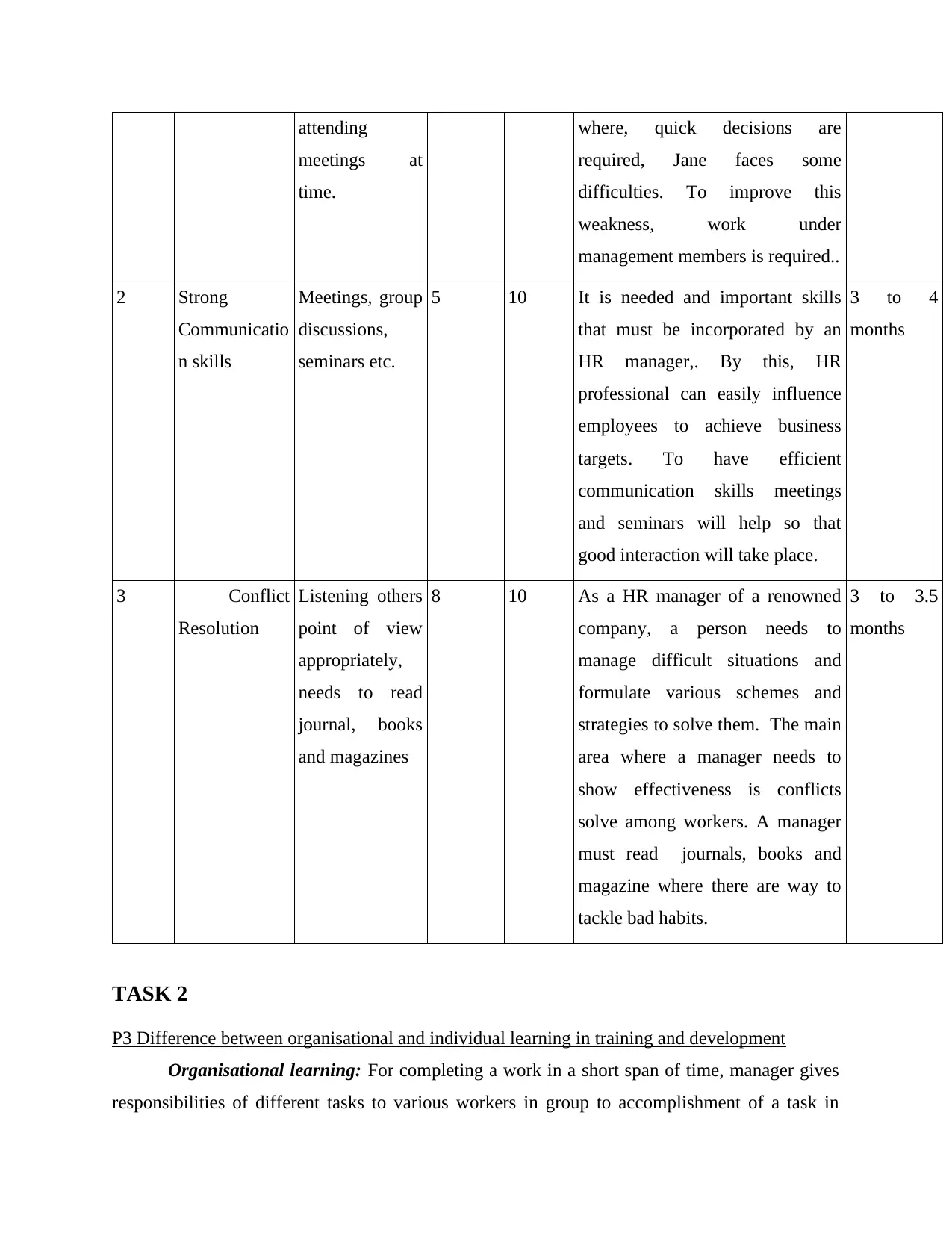
attending
meetings at
time.
where, quick decisions are
required, Jane faces some
difficulties. To improve this
weakness, work under
management members is required..
2 Strong
Communicatio
n skills
Meetings, group
discussions,
seminars etc.
5 10 It is needed and important skills
that must be incorporated by an
HR manager,. By this, HR
professional can easily influence
employees to achieve business
targets. To have efficient
communication skills meetings
and seminars will help so that
good interaction will take place.
3 to 4
months
3 Conflict
Resolution
Listening others
point of view
appropriately,
needs to read
journal, books
and magazines
8 10 As a HR manager of a renowned
company, a person needs to
manage difficult situations and
formulate various schemes and
strategies to solve them. The main
area where a manager needs to
show effectiveness is conflicts
solve among workers. A manager
must read journals, books and
magazine where there are way to
tackle bad habits.
3 to 3.5
months
TASK 2
P3 Difference between organisational and individual learning in training and development
Organisational learning: For completing a work in a short span of time, manager gives
responsibilities of different tasks to various workers in group to accomplishment of a task in
meetings at
time.
where, quick decisions are
required, Jane faces some
difficulties. To improve this
weakness, work under
management members is required..
2 Strong
Communicatio
n skills
Meetings, group
discussions,
seminars etc.
5 10 It is needed and important skills
that must be incorporated by an
HR manager,. By this, HR
professional can easily influence
employees to achieve business
targets. To have efficient
communication skills meetings
and seminars will help so that
good interaction will take place.
3 to 4
months
3 Conflict
Resolution
Listening others
point of view
appropriately,
needs to read
journal, books
and magazines
8 10 As a HR manager of a renowned
company, a person needs to
manage difficult situations and
formulate various schemes and
strategies to solve them. The main
area where a manager needs to
show effectiveness is conflicts
solve among workers. A manager
must read journals, books and
magazine where there are way to
tackle bad habits.
3 to 3.5
months
TASK 2
P3 Difference between organisational and individual learning in training and development
Organisational learning: For completing a work in a short span of time, manager gives
responsibilities of different tasks to various workers in group to accomplishment of a task in
⊘ This is a preview!⊘
Do you want full access?
Subscribe today to unlock all pages.

Trusted by 1+ million students worldwide
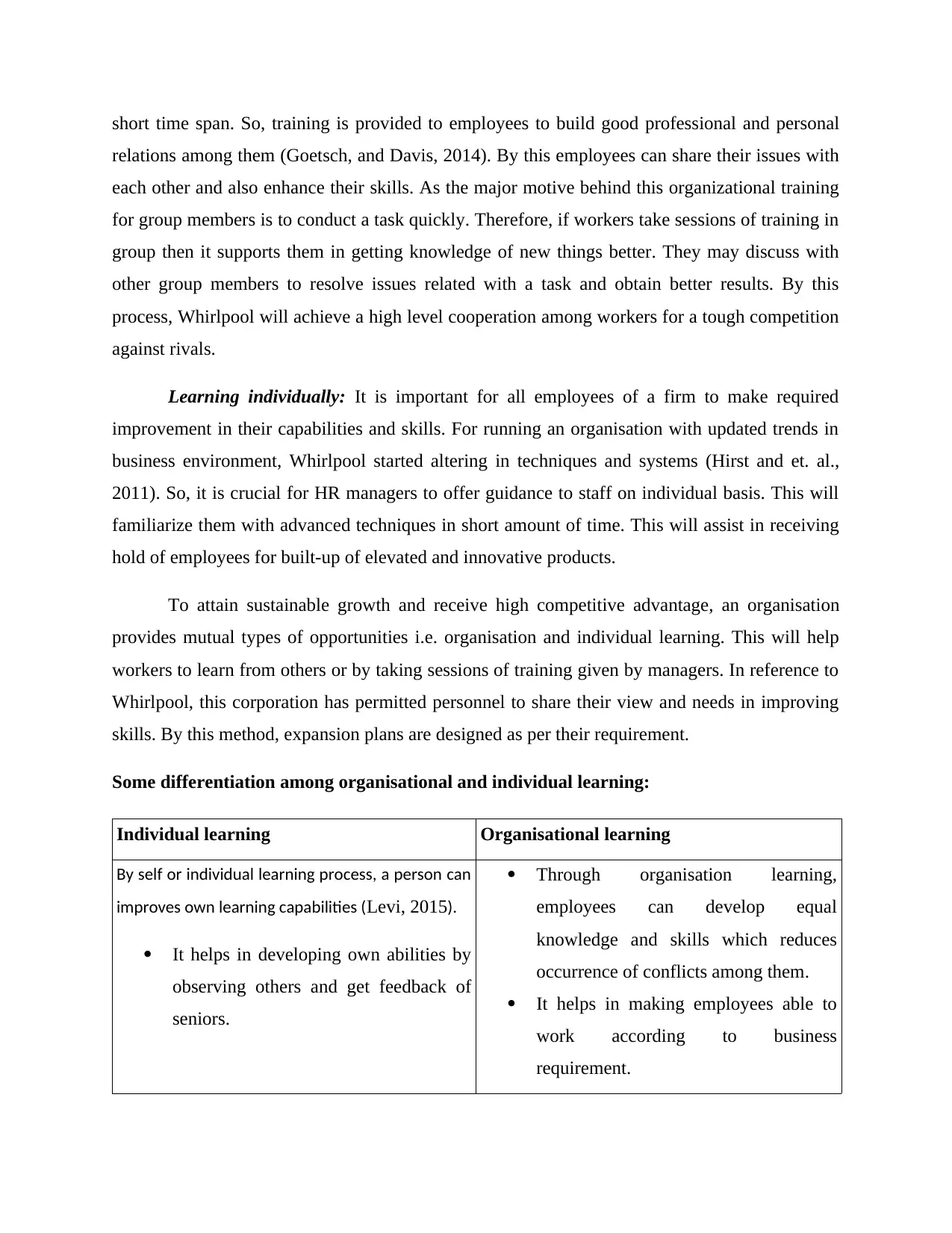
short time span. So, training is provided to employees to build good professional and personal
relations among them (Goetsch, and Davis, 2014). By this employees can share their issues with
each other and also enhance their skills. As the major motive behind this organizational training
for group members is to conduct a task quickly. Therefore, if workers take sessions of training in
group then it supports them in getting knowledge of new things better. They may discuss with
other group members to resolve issues related with a task and obtain better results. By this
process, Whirlpool will achieve a high level cooperation among workers for a tough competition
against rivals.
Learning individually: It is important for all employees of a firm to make required
improvement in their capabilities and skills. For running an organisation with updated trends in
business environment, Whirlpool started altering in techniques and systems (Hirst and et. al.,
2011). So, it is crucial for HR managers to offer guidance to staff on individual basis. This will
familiarize them with advanced techniques in short amount of time. This will assist in receiving
hold of employees for built-up of elevated and innovative products.
To attain sustainable growth and receive high competitive advantage, an organisation
provides mutual types of opportunities i.e. organisation and individual learning. This will help
workers to learn from others or by taking sessions of training given by managers. In reference to
Whirlpool, this corporation has permitted personnel to share their view and needs in improving
skills. By this method, expansion plans are designed as per their requirement.
Some differentiation among organisational and individual learning:
Individual learning Organisational learning
By self or individual learning process, a person can
improves own learning capabilities (Levi, 2015).
It helps in developing own abilities by
observing others and get feedback of
seniors.
Through organisation learning,
employees can develop equal
knowledge and skills which reduces
occurrence of conflicts among them.
It helps in making employees able to
work according to business
requirement.
relations among them (Goetsch, and Davis, 2014). By this employees can share their issues with
each other and also enhance their skills. As the major motive behind this organizational training
for group members is to conduct a task quickly. Therefore, if workers take sessions of training in
group then it supports them in getting knowledge of new things better. They may discuss with
other group members to resolve issues related with a task and obtain better results. By this
process, Whirlpool will achieve a high level cooperation among workers for a tough competition
against rivals.
Learning individually: It is important for all employees of a firm to make required
improvement in their capabilities and skills. For running an organisation with updated trends in
business environment, Whirlpool started altering in techniques and systems (Hirst and et. al.,
2011). So, it is crucial for HR managers to offer guidance to staff on individual basis. This will
familiarize them with advanced techniques in short amount of time. This will assist in receiving
hold of employees for built-up of elevated and innovative products.
To attain sustainable growth and receive high competitive advantage, an organisation
provides mutual types of opportunities i.e. organisation and individual learning. This will help
workers to learn from others or by taking sessions of training given by managers. In reference to
Whirlpool, this corporation has permitted personnel to share their view and needs in improving
skills. By this method, expansion plans are designed as per their requirement.
Some differentiation among organisational and individual learning:
Individual learning Organisational learning
By self or individual learning process, a person can
improves own learning capabilities (Levi, 2015).
It helps in developing own abilities by
observing others and get feedback of
seniors.
Through organisation learning,
employees can develop equal
knowledge and skills which reduces
occurrence of conflicts among them.
It helps in making employees able to
work according to business
requirement.
Paraphrase This Document
Need a fresh take? Get an instant paraphrase of this document with our AI Paraphraser
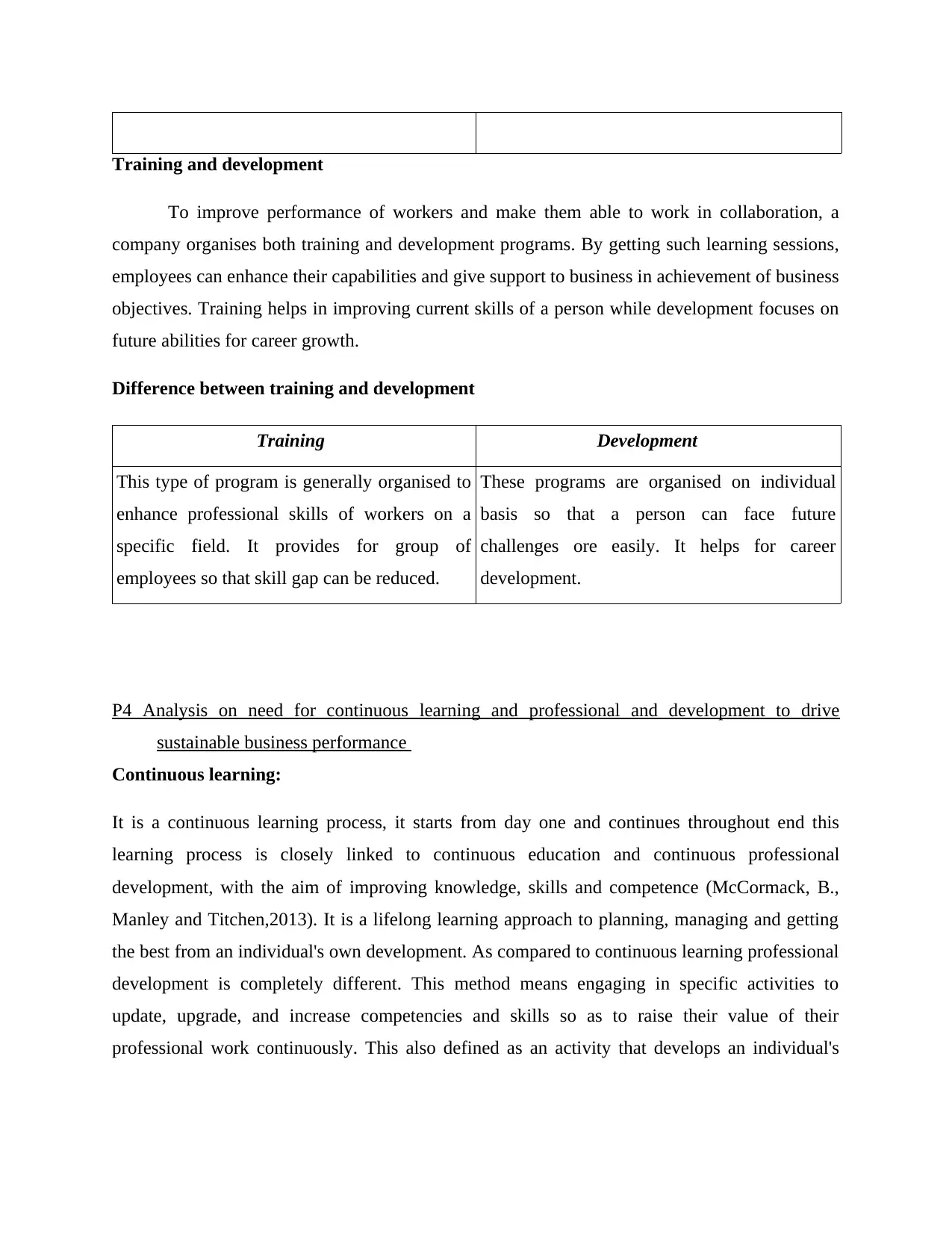
Training and development
To improve performance of workers and make them able to work in collaboration, a
company organises both training and development programs. By getting such learning sessions,
employees can enhance their capabilities and give support to business in achievement of business
objectives. Training helps in improving current skills of a person while development focuses on
future abilities for career growth.
Difference between training and development
Training Development
This type of program is generally organised to
enhance professional skills of workers on a
specific field. It provides for group of
employees so that skill gap can be reduced.
These programs are organised on individual
basis so that a person can face future
challenges ore easily. It helps for career
development.
P4 Analysis on need for continuous learning and professional and development to drive
sustainable business performance
Continuous learning:
It is a continuous learning process, it starts from day one and continues throughout end this
learning process is closely linked to continuous education and continuous professional
development, with the aim of improving knowledge, skills and competence (McCormack, B.,
Manley and Titchen,2013). It is a lifelong learning approach to planning, managing and getting
the best from an individual's own development. As compared to continuous learning professional
development is completely different. This method means engaging in specific activities to
update, upgrade, and increase competencies and skills so as to raise their value of their
professional work continuously. This also defined as an activity that develops an individual's
To improve performance of workers and make them able to work in collaboration, a
company organises both training and development programs. By getting such learning sessions,
employees can enhance their capabilities and give support to business in achievement of business
objectives. Training helps in improving current skills of a person while development focuses on
future abilities for career growth.
Difference between training and development
Training Development
This type of program is generally organised to
enhance professional skills of workers on a
specific field. It provides for group of
employees so that skill gap can be reduced.
These programs are organised on individual
basis so that a person can face future
challenges ore easily. It helps for career
development.
P4 Analysis on need for continuous learning and professional and development to drive
sustainable business performance
Continuous learning:
It is a continuous learning process, it starts from day one and continues throughout end this
learning process is closely linked to continuous education and continuous professional
development, with the aim of improving knowledge, skills and competence (McCormack, B.,
Manley and Titchen,2013). It is a lifelong learning approach to planning, managing and getting
the best from an individual's own development. As compared to continuous learning professional
development is completely different. This method means engaging in specific activities to
update, upgrade, and increase competencies and skills so as to raise their value of their
professional work continuously. This also defined as an activity that develops an individual's
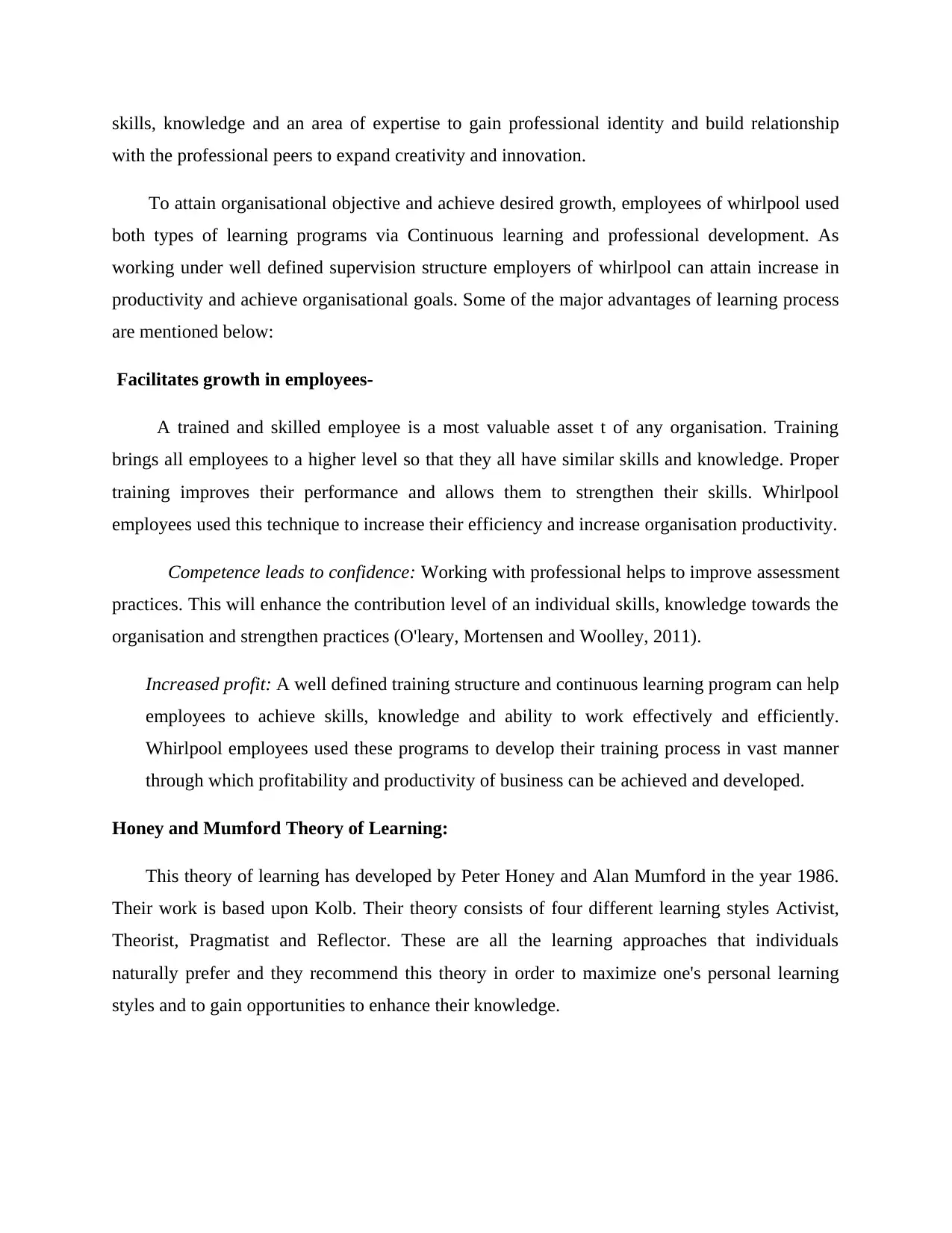
skills, knowledge and an area of expertise to gain professional identity and build relationship
with the professional peers to expand creativity and innovation.
To attain organisational objective and achieve desired growth, employees of whirlpool used
both types of learning programs via Continuous learning and professional development. As
working under well defined supervision structure employers of whirlpool can attain increase in
productivity and achieve organisational goals. Some of the major advantages of learning process
are mentioned below:
Facilitates growth in employees-
A trained and skilled employee is a most valuable asset t of any organisation. Training
brings all employees to a higher level so that they all have similar skills and knowledge. Proper
training improves their performance and allows them to strengthen their skills. Whirlpool
employees used this technique to increase their efficiency and increase organisation productivity.
Competence leads to confidence: Working with professional helps to improve assessment
practices. This will enhance the contribution level of an individual skills, knowledge towards the
organisation and strengthen practices (O'leary, Mortensen and Woolley, 2011).
Increased profit: A well defined training structure and continuous learning program can help
employees to achieve skills, knowledge and ability to work effectively and efficiently.
Whirlpool employees used these programs to develop their training process in vast manner
through which profitability and productivity of business can be achieved and developed.
Honey and Mumford Theory of Learning:
This theory of learning has developed by Peter Honey and Alan Mumford in the year 1986.
Their work is based upon Kolb. Their theory consists of four different learning styles Activist,
Theorist, Pragmatist and Reflector. These are all the learning approaches that individuals
naturally prefer and they recommend this theory in order to maximize one's personal learning
styles and to gain opportunities to enhance their knowledge.
with the professional peers to expand creativity and innovation.
To attain organisational objective and achieve desired growth, employees of whirlpool used
both types of learning programs via Continuous learning and professional development. As
working under well defined supervision structure employers of whirlpool can attain increase in
productivity and achieve organisational goals. Some of the major advantages of learning process
are mentioned below:
Facilitates growth in employees-
A trained and skilled employee is a most valuable asset t of any organisation. Training
brings all employees to a higher level so that they all have similar skills and knowledge. Proper
training improves their performance and allows them to strengthen their skills. Whirlpool
employees used this technique to increase their efficiency and increase organisation productivity.
Competence leads to confidence: Working with professional helps to improve assessment
practices. This will enhance the contribution level of an individual skills, knowledge towards the
organisation and strengthen practices (O'leary, Mortensen and Woolley, 2011).
Increased profit: A well defined training structure and continuous learning program can help
employees to achieve skills, knowledge and ability to work effectively and efficiently.
Whirlpool employees used these programs to develop their training process in vast manner
through which profitability and productivity of business can be achieved and developed.
Honey and Mumford Theory of Learning:
This theory of learning has developed by Peter Honey and Alan Mumford in the year 1986.
Their work is based upon Kolb. Their theory consists of four different learning styles Activist,
Theorist, Pragmatist and Reflector. These are all the learning approaches that individuals
naturally prefer and they recommend this theory in order to maximize one's personal learning
styles and to gain opportunities to enhance their knowledge.
⊘ This is a preview!⊘
Do you want full access?
Subscribe today to unlock all pages.

Trusted by 1+ million students worldwide
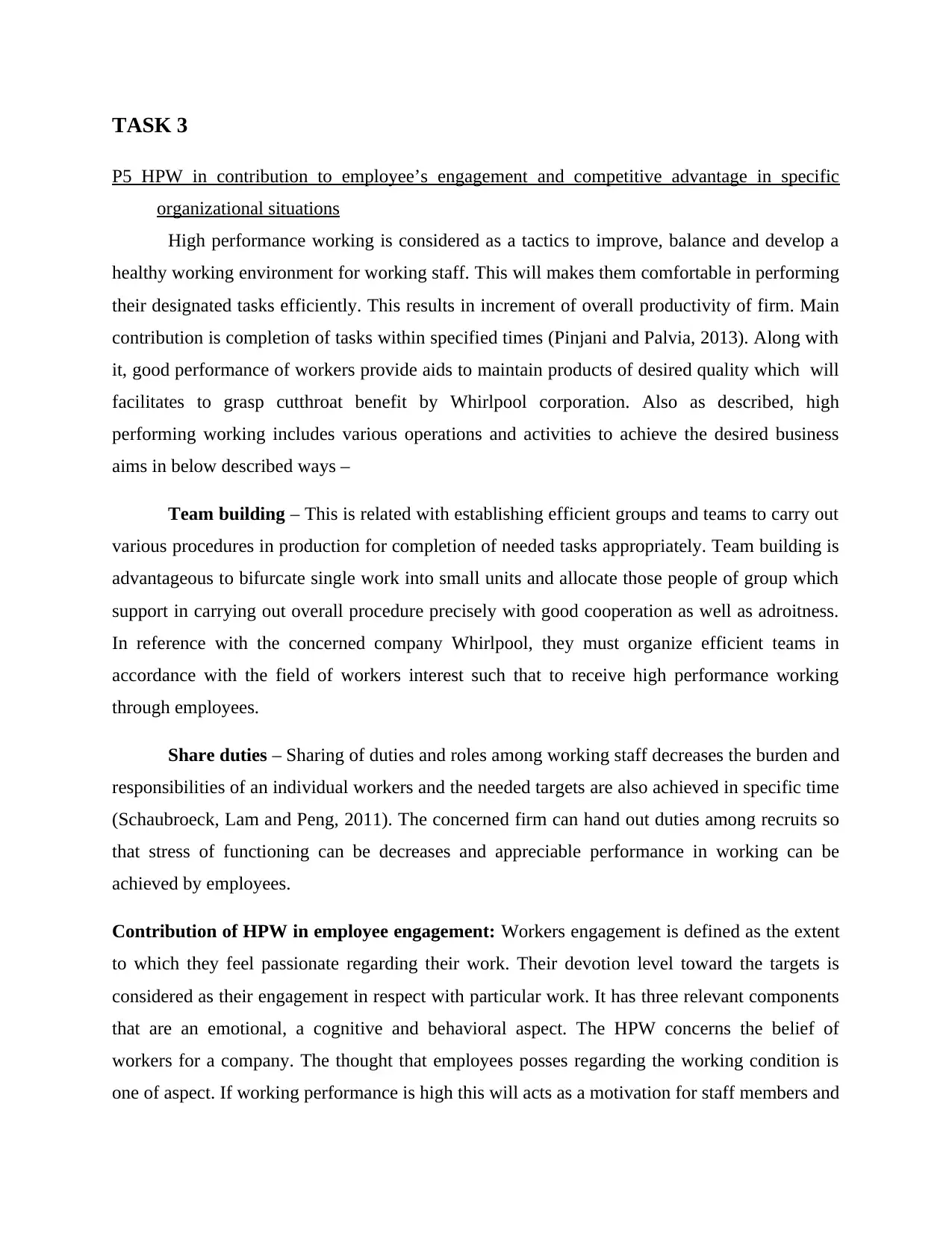
TASK 3
P5 HPW in contribution to employee’s engagement and competitive advantage in specific
organizational situations
High performance working is considered as a tactics to improve, balance and develop a
healthy working environment for working staff. This will makes them comfortable in performing
their designated tasks efficiently. This results in increment of overall productivity of firm. Main
contribution is completion of tasks within specified times (Pinjani and Palvia, 2013). Along with
it, good performance of workers provide aids to maintain products of desired quality which will
facilitates to grasp cutthroat benefit by Whirlpool corporation. Also as described, high
performing working includes various operations and activities to achieve the desired business
aims in below described ways –
Team building – This is related with establishing efficient groups and teams to carry out
various procedures in production for completion of needed tasks appropriately. Team building is
advantageous to bifurcate single work into small units and allocate those people of group which
support in carrying out overall procedure precisely with good cooperation as well as adroitness.
In reference with the concerned company Whirlpool, they must organize efficient teams in
accordance with the field of workers interest such that to receive high performance working
through employees.
Share duties – Sharing of duties and roles among working staff decreases the burden and
responsibilities of an individual workers and the needed targets are also achieved in specific time
(Schaubroeck, Lam and Peng, 2011). The concerned firm can hand out duties among recruits so
that stress of functioning can be decreases and appreciable performance in working can be
achieved by employees.
Contribution of HPW in employee engagement: Workers engagement is defined as the extent
to which they feel passionate regarding their work. Their devotion level toward the targets is
considered as their engagement in respect with particular work. It has three relevant components
that are an emotional, a cognitive and behavioral aspect. The HPW concerns the belief of
workers for a company. The thought that employees posses regarding the working condition is
one of aspect. If working performance is high this will acts as a motivation for staff members and
P5 HPW in contribution to employee’s engagement and competitive advantage in specific
organizational situations
High performance working is considered as a tactics to improve, balance and develop a
healthy working environment for working staff. This will makes them comfortable in performing
their designated tasks efficiently. This results in increment of overall productivity of firm. Main
contribution is completion of tasks within specified times (Pinjani and Palvia, 2013). Along with
it, good performance of workers provide aids to maintain products of desired quality which will
facilitates to grasp cutthroat benefit by Whirlpool corporation. Also as described, high
performing working includes various operations and activities to achieve the desired business
aims in below described ways –
Team building – This is related with establishing efficient groups and teams to carry out
various procedures in production for completion of needed tasks appropriately. Team building is
advantageous to bifurcate single work into small units and allocate those people of group which
support in carrying out overall procedure precisely with good cooperation as well as adroitness.
In reference with the concerned company Whirlpool, they must organize efficient teams in
accordance with the field of workers interest such that to receive high performance working
through employees.
Share duties – Sharing of duties and roles among working staff decreases the burden and
responsibilities of an individual workers and the needed targets are also achieved in specific time
(Schaubroeck, Lam and Peng, 2011). The concerned firm can hand out duties among recruits so
that stress of functioning can be decreases and appreciable performance in working can be
achieved by employees.
Contribution of HPW in employee engagement: Workers engagement is defined as the extent
to which they feel passionate regarding their work. Their devotion level toward the targets is
considered as their engagement in respect with particular work. It has three relevant components
that are an emotional, a cognitive and behavioral aspect. The HPW concerns the belief of
workers for a company. The thought that employees posses regarding the working condition is
one of aspect. If working performance is high this will acts as a motivation for staff members and
Paraphrase This Document
Need a fresh take? Get an instant paraphrase of this document with our AI Paraphraser
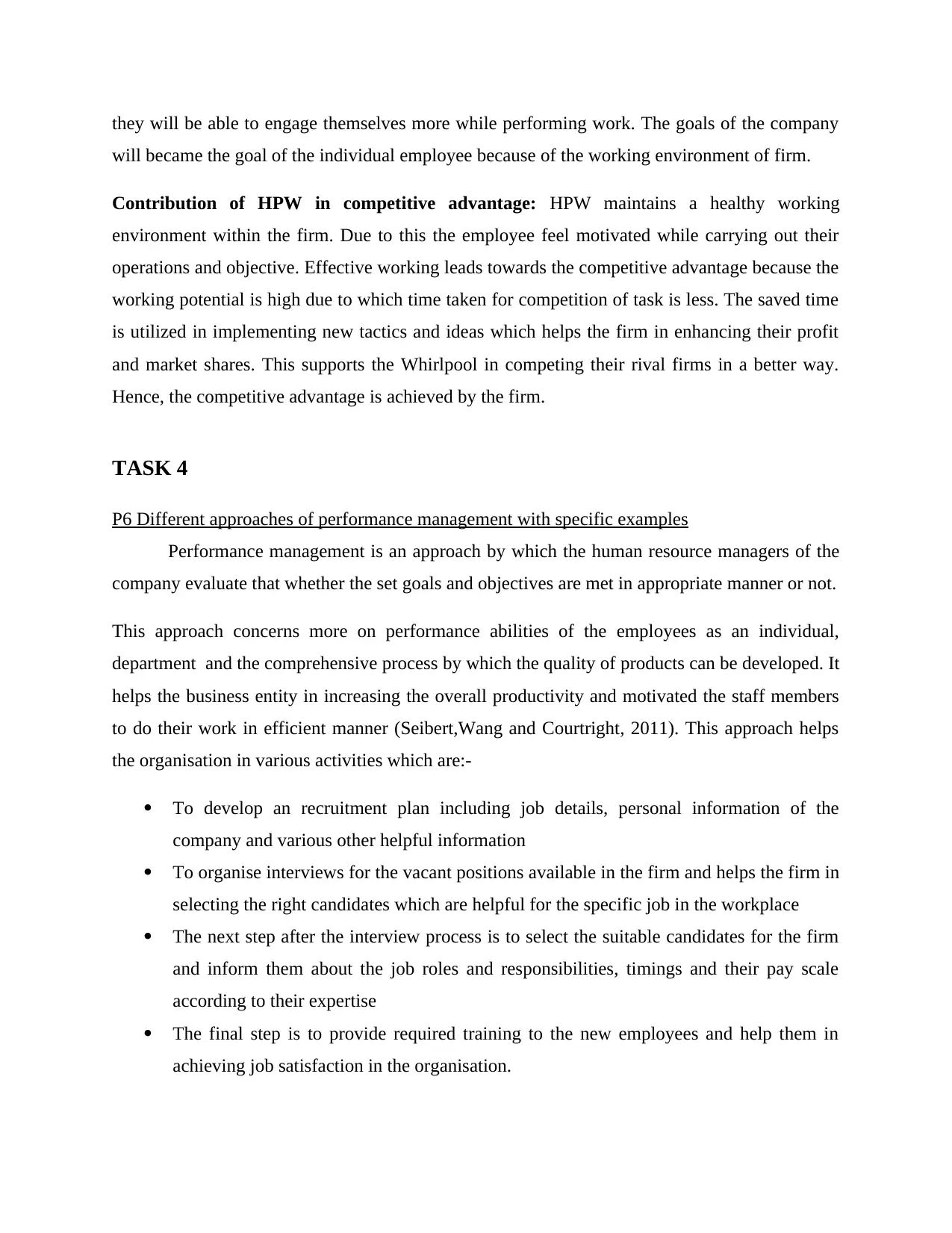
they will be able to engage themselves more while performing work. The goals of the company
will became the goal of the individual employee because of the working environment of firm.
Contribution of HPW in competitive advantage: HPW maintains a healthy working
environment within the firm. Due to this the employee feel motivated while carrying out their
operations and objective. Effective working leads towards the competitive advantage because the
working potential is high due to which time taken for competition of task is less. The saved time
is utilized in implementing new tactics and ideas which helps the firm in enhancing their profit
and market shares. This supports the Whirlpool in competing their rival firms in a better way.
Hence, the competitive advantage is achieved by the firm.
TASK 4
P6 Different approaches of performance management with specific examples
Performance management is an approach by which the human resource managers of the
company evaluate that whether the set goals and objectives are met in appropriate manner or not.
This approach concerns more on performance abilities of the employees as an individual,
department and the comprehensive process by which the quality of products can be developed. It
helps the business entity in increasing the overall productivity and motivated the staff members
to do their work in efficient manner (Seibert,Wang and Courtright, 2011). This approach helps
the organisation in various activities which are:-
To develop an recruitment plan including job details, personal information of the
company and various other helpful information
To organise interviews for the vacant positions available in the firm and helps the firm in
selecting the right candidates which are helpful for the specific job in the workplace
The next step after the interview process is to select the suitable candidates for the firm
and inform them about the job roles and responsibilities, timings and their pay scale
according to their expertise
The final step is to provide required training to the new employees and help them in
achieving job satisfaction in the organisation.
will became the goal of the individual employee because of the working environment of firm.
Contribution of HPW in competitive advantage: HPW maintains a healthy working
environment within the firm. Due to this the employee feel motivated while carrying out their
operations and objective. Effective working leads towards the competitive advantage because the
working potential is high due to which time taken for competition of task is less. The saved time
is utilized in implementing new tactics and ideas which helps the firm in enhancing their profit
and market shares. This supports the Whirlpool in competing their rival firms in a better way.
Hence, the competitive advantage is achieved by the firm.
TASK 4
P6 Different approaches of performance management with specific examples
Performance management is an approach by which the human resource managers of the
company evaluate that whether the set goals and objectives are met in appropriate manner or not.
This approach concerns more on performance abilities of the employees as an individual,
department and the comprehensive process by which the quality of products can be developed. It
helps the business entity in increasing the overall productivity and motivated the staff members
to do their work in efficient manner (Seibert,Wang and Courtright, 2011). This approach helps
the organisation in various activities which are:-
To develop an recruitment plan including job details, personal information of the
company and various other helpful information
To organise interviews for the vacant positions available in the firm and helps the firm in
selecting the right candidates which are helpful for the specific job in the workplace
The next step after the interview process is to select the suitable candidates for the firm
and inform them about the job roles and responsibilities, timings and their pay scale
according to their expertise
The final step is to provide required training to the new employees and help them in
achieving job satisfaction in the organisation.
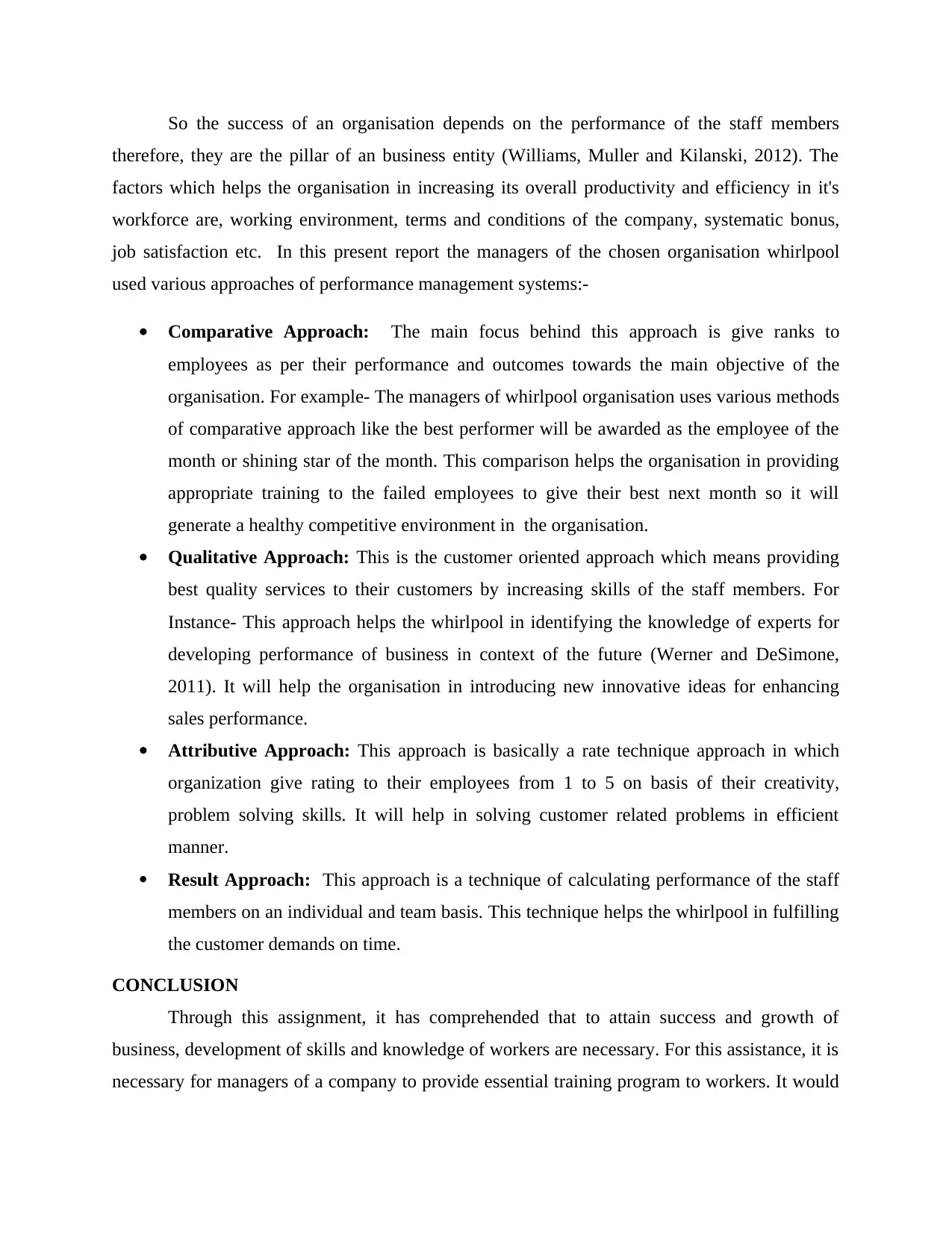
So the success of an organisation depends on the performance of the staff members
therefore, they are the pillar of an business entity (Williams, Muller and Kilanski, 2012). The
factors which helps the organisation in increasing its overall productivity and efficiency in it's
workforce are, working environment, terms and conditions of the company, systematic bonus,
job satisfaction etc. In this present report the managers of the chosen organisation whirlpool
used various approaches of performance management systems:-
Comparative Approach: The main focus behind this approach is give ranks to
employees as per their performance and outcomes towards the main objective of the
organisation. For example- The managers of whirlpool organisation uses various methods
of comparative approach like the best performer will be awarded as the employee of the
month or shining star of the month. This comparison helps the organisation in providing
appropriate training to the failed employees to give their best next month so it will
generate a healthy competitive environment in the organisation.
Qualitative Approach: This is the customer oriented approach which means providing
best quality services to their customers by increasing skills of the staff members. For
Instance- This approach helps the whirlpool in identifying the knowledge of experts for
developing performance of business in context of the future (Werner and DeSimone,
2011). It will help the organisation in introducing new innovative ideas for enhancing
sales performance.
Attributive Approach: This approach is basically a rate technique approach in which
organization give rating to their employees from 1 to 5 on basis of their creativity,
problem solving skills. It will help in solving customer related problems in efficient
manner.
Result Approach: This approach is a technique of calculating performance of the staff
members on an individual and team basis. This technique helps the whirlpool in fulfilling
the customer demands on time.
CONCLUSION
Through this assignment, it has comprehended that to attain success and growth of
business, development of skills and knowledge of workers are necessary. For this assistance, it is
necessary for managers of a company to provide essential training program to workers. It would
therefore, they are the pillar of an business entity (Williams, Muller and Kilanski, 2012). The
factors which helps the organisation in increasing its overall productivity and efficiency in it's
workforce are, working environment, terms and conditions of the company, systematic bonus,
job satisfaction etc. In this present report the managers of the chosen organisation whirlpool
used various approaches of performance management systems:-
Comparative Approach: The main focus behind this approach is give ranks to
employees as per their performance and outcomes towards the main objective of the
organisation. For example- The managers of whirlpool organisation uses various methods
of comparative approach like the best performer will be awarded as the employee of the
month or shining star of the month. This comparison helps the organisation in providing
appropriate training to the failed employees to give their best next month so it will
generate a healthy competitive environment in the organisation.
Qualitative Approach: This is the customer oriented approach which means providing
best quality services to their customers by increasing skills of the staff members. For
Instance- This approach helps the whirlpool in identifying the knowledge of experts for
developing performance of business in context of the future (Werner and DeSimone,
2011). It will help the organisation in introducing new innovative ideas for enhancing
sales performance.
Attributive Approach: This approach is basically a rate technique approach in which
organization give rating to their employees from 1 to 5 on basis of their creativity,
problem solving skills. It will help in solving customer related problems in efficient
manner.
Result Approach: This approach is a technique of calculating performance of the staff
members on an individual and team basis. This technique helps the whirlpool in fulfilling
the customer demands on time.
CONCLUSION
Through this assignment, it has comprehended that to attain success and growth of
business, development of skills and knowledge of workers are necessary. For this assistance, it is
necessary for managers of a company to provide essential training program to workers. It would
⊘ This is a preview!⊘
Do you want full access?
Subscribe today to unlock all pages.

Trusted by 1+ million students worldwide
1 out of 15
Related Documents
Your All-in-One AI-Powered Toolkit for Academic Success.
+13062052269
info@desklib.com
Available 24*7 on WhatsApp / Email
![[object Object]](/_next/static/media/star-bottom.7253800d.svg)
Unlock your academic potential
Copyright © 2020–2025 A2Z Services. All Rights Reserved. Developed and managed by ZUCOL.





